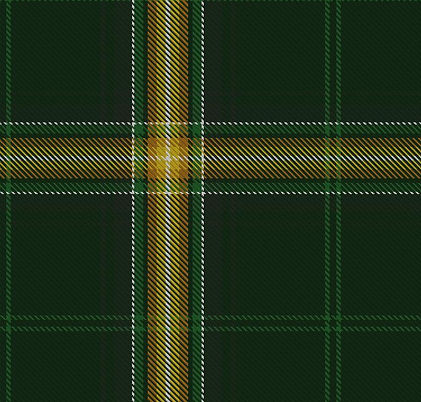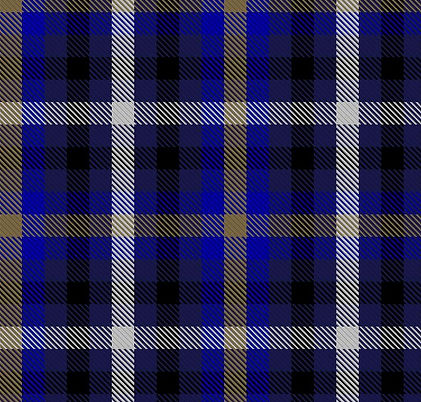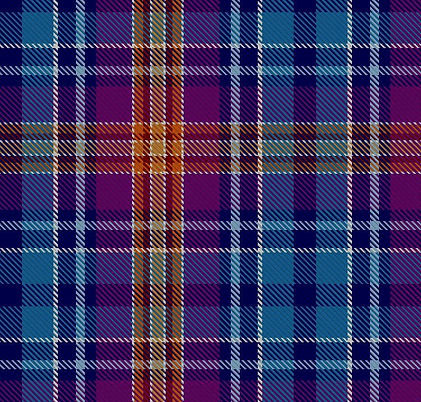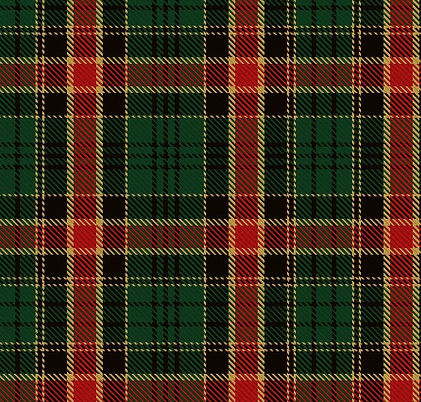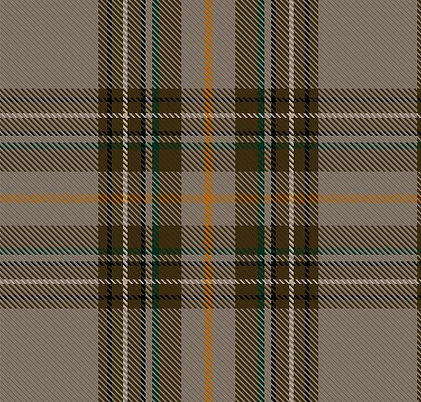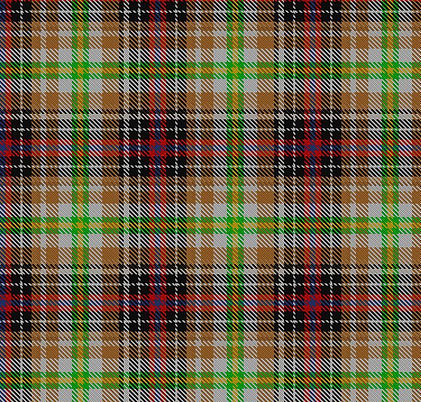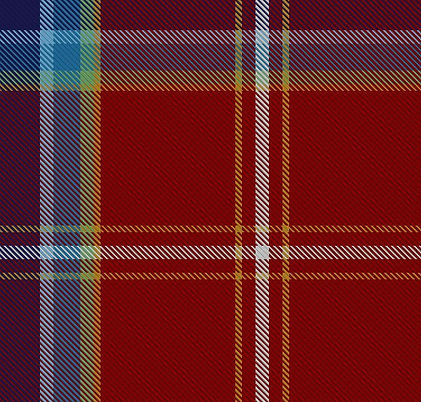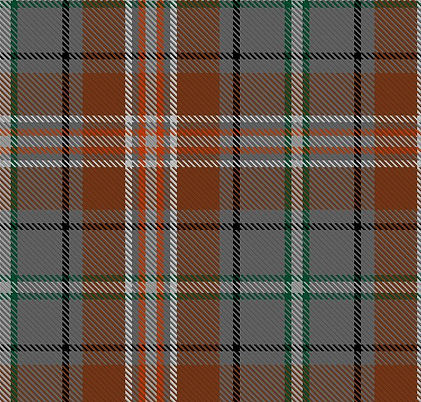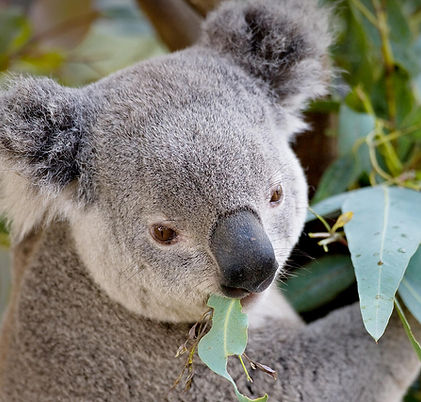Real Creatures
Tartans have been designed to pay homage to wild creatures, domesticated animals, endangered species and beloved pets.
Click any picture to navigate to the page of interest for more information about this tartan or its associated day.
Groundhog
Feb 2
Groundhog Day
From the designer: "If the sun comes out on a clear blue morning, the Groundhog will see his shadow. Again, the darker "shadow" portion is asymmetrical as if light is shining on the lines from the left hand side. The turquoise seemed to go with the bright yellow and reminded me of a warm Caribbean vacation, which I am sure many people on the East Coast may be dreaming of right now."
Edinburgh Zoo Panda
Mar 16
Panda Day
Created to celebrate the arrival of a breeding pair of pandas at Edinburgh Zoo. The main colours of the tartan are black and white, directly representing the Panda’s. Grey shades have been added to soften the tartan as well as to convey the gradation of colour from black to white, as seen on the Panda’s fur. The red represents China as the pandas are their gift. Green has also been included to represent the pandas' favourite food, bamboo.
Springbok
Apr 3
Safari Day
Produced to celebrate the Springbok (antidorcas marsupialis), a swift and graceful gazelle of Africa, this animal gets its common name from its characteristic jumping display - 'pronk' in Afrikaans, meaning to boast or show off. The many different shades of green resemble the fertile veld of South Africa where the Springbok grazes. The Springbok itself was the inspiration for the centre of the sett, focussing on its beautiful lustrous eyes and the white patch on its back.
Australian Heavy Horse
Jun 14
Heavy Horse Day
Designed, firstly for the Clydesdale breed and then further extended to include all heavy work horse breeds in Australia, in recognition of the heavy horses in the establishment of agriculture in Australia and the revival of their use in the new millennium. The main colours of the tartan represent the breed of heavy horses. The dark grey and black also represents the use of horses in industry, with green for Australian agriculture and brown for the ploughed fields.
REAL CREATURES COLLECTION
Oct-4
World Animal Day
Arctic Fox
Dec 26
Foxing Day (Fox Appreciation Day)
This tartan by Carol A.L. Martin, "represents the changing colour phases of the thick fur coat of the Arctic fox, which are shades of brown in summer and white and bluish-grey in winter. Their eyes are often a deep golden yellow. The Arctic fox is native to Arctic regions of the Northern Hemisphere and is the only land mammal native to Iceland."
Western Monarch
Feb 5
Western Monarch Day
The Western Monarch (Danaus plexippus) may be the most familiar North American butterfly, with its easily recognizable black, orange, and white wing pattern. The North American monarch population is notable for its annual southward late-summer/autumn migration from the United States and southern Canada to Mexico. During the fall migration, monarchs cover thousands of miles, with a corresponding multi-generational return north.
Blue Whale and Calf
Feb 15
World Whale Weekend
All blue whale groups make calls at a fundamental frequency between 10 and 40 Hz; the lowest frequency sound a human can typically perceive is 20 Hz. Blue whale calls last between ten and thirty seconds. Blue whales off the coast of Sri Lanka have been repeatedly recorded making "songs" of four notes, lasting about two minutes each, reminiscent of the well-known humpback whale songs.
Polar Bears
Feb 27
Polar Bear Day
Their scientific name means "maritime bear", and derives from the fact that polar bears hunt their preferred food of seals from the edge of sea ice, often living off fat reserves when no sea ice is present. Because of their dependence on the sea ice, polar bears are classified as marine mammals.
California red-legged frog
Mar 20
World Frog Day
The California red-legged frog is found in California and extreme northern Baja California, northwestern Mexico. This species now occurs most commonly along the northern and southern Coast Ranges, and in isolated areas in the foothills of the Sierra Nevada mountains.
Beagles
Apr 22
Beagle Day
From medieval times, beagle was used as a description for smaller hounds of many breeds. Miniature breeds of beagle-type dogs were known from the times of Edward II and Henry VII, who both had packs of the very diminutive Glove Beagle, and Queen Elizabeth I kept a breed known as a Pocket Beagle, which stood only 8 to 9 inches at the shoulder.
Guinea Pig in Glen Plaid
Jul 16
Guinea Pig Day
The domestic guinea pig has enjoyed widespread popularity as a household pet, a type of pocket pet, ever since its introduction by European traders in the 16th century. Their docile nature; friendly, even affectionate responsiveness to handling and feeding; and the relative ease of caring for them continue to make guinea pigs a popular choice of pet.
Luna Moths
Jul 24
Moth Days
Luna Moths are huge moths, members of the Saturniidae family, also known as the "Giant Silkworm Moths" with a wingspan of four and a half inches. They have a white body, pinkish legs, and huge pale green wings. The hindwings have eyespots and long tails. They fly only at night, in spring and early summer.
Baby Pink Albino Elephant with Herd
Aug 12
World Elephant Day
Although the term is associated with drunken hallucination, A pink elephant (also white or albino elephant) is a rare kind of elephant, but not a distinct species. Although often depicted as snow white, their skin is normally a soft reddish-brown, turning a light pink when wet.
Timber Wolves
Aug 13
Wolf Day
Many ancient civilizations paired wolves with the moon in both images and literature, a coupling which eventually evolved into today's popular belief that wolves howl at the moon. While experts have found no connection between the phases of the moon and wolf howling, pointing their faces upwards while howling allows wolves to project their calls farther
Little Brown Bat (Myotis lucifugus)
Aug 27
Baby Bat Night
Bats are the only flying mammals, but the species of vampire bats have an even more interesting distinction - they are the only mammals that feed entirely on blood (hemophagia), usually livestock. These bats sleep during the day in total darkness, suspended upside down from the roofs of caves. They typically gather in colonies of about 100 animals, but sometimes live in groups of 1,000 or more.
Oct-4
World Animal Day
Wolf or Werewolf?
Oct 24
Werewolf Night
The magical ability to assume the form and characteristics of a wolf is known as lycanthropism, or lycanthropy. There was no widespread belief in werewolves in medieval Europe before the 14th century, though the concept of animal shape-shifting goes back much further.
Palomino
Dec 13
The Day of the Horse
The Palomino horse is named for its beautiful golden coat and white mane and tail. Due to their distinct color, palominos stand out in a show ring, and are much sought after as parade horses. They were particularly popular in movies and television during the 1940s and 1950s.
Arctic Fox
Dec 26
Foxing Day (Fox Appreciation Day)
The Arctic fox (Vulpes lagopus), also known as the white fox, polar fox, or snow fox, is a small fox native to the Arctic regions of the Northern Hemisphere and common throughout the Arctic tundra biome. It is well adapted to living in cold environments, and is best known for its thick, warm fur that is also used as camouflage. On average, Arctic foxes only live 3-4 years in the wild.















